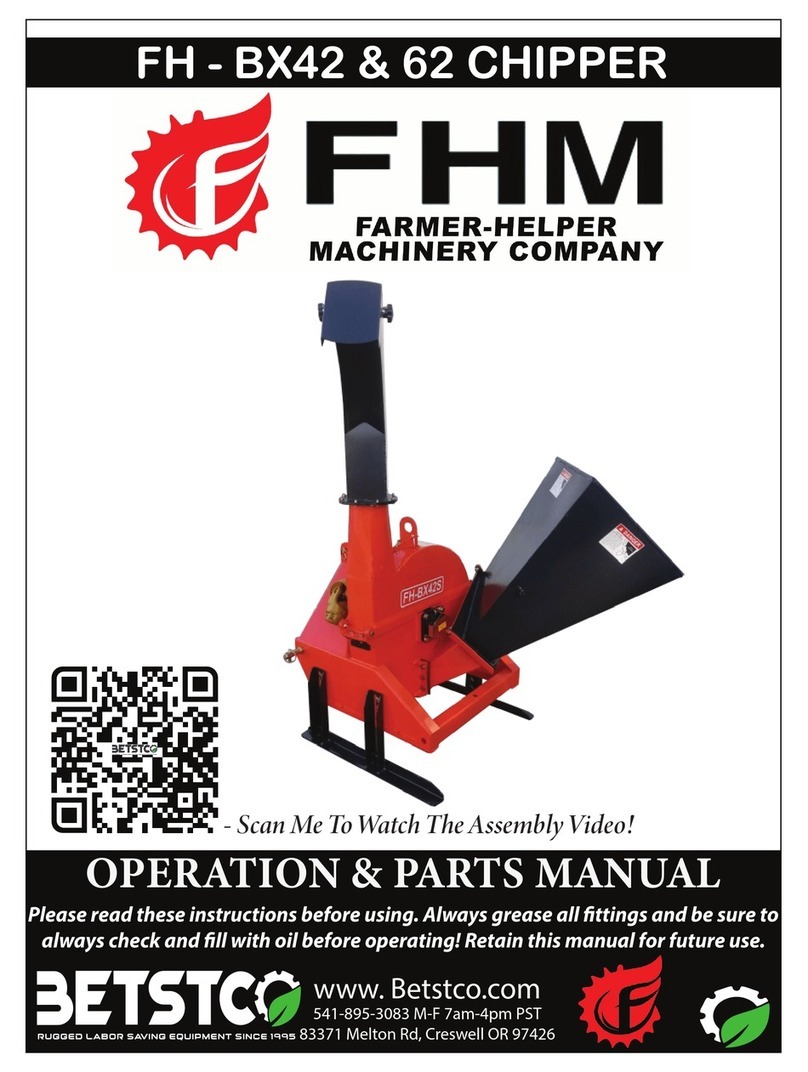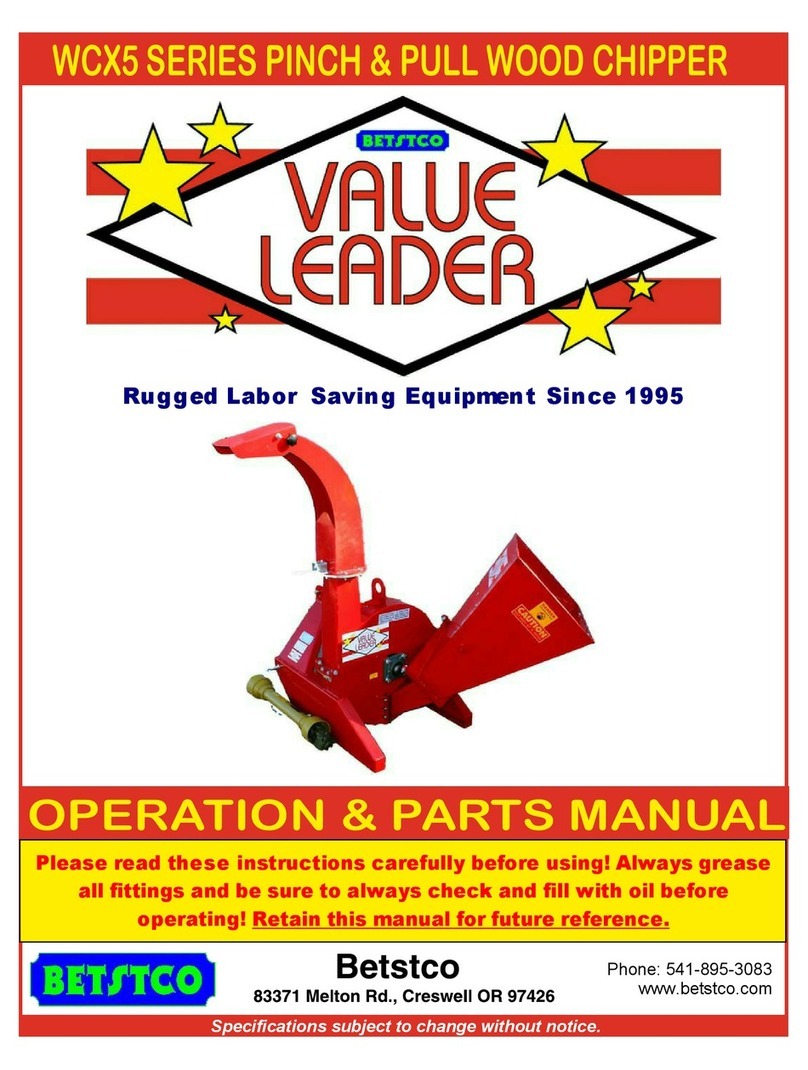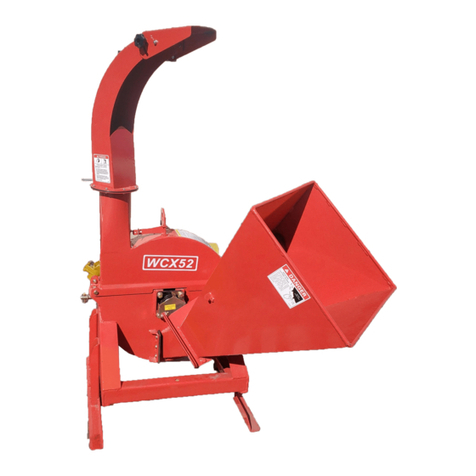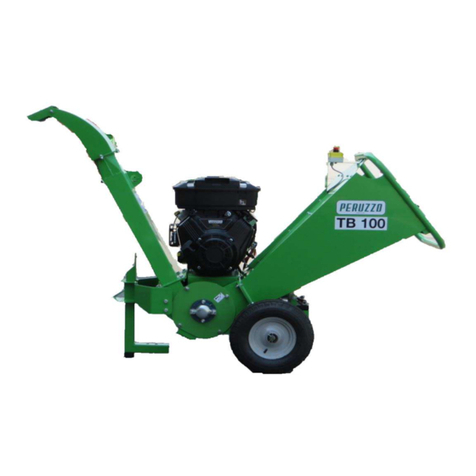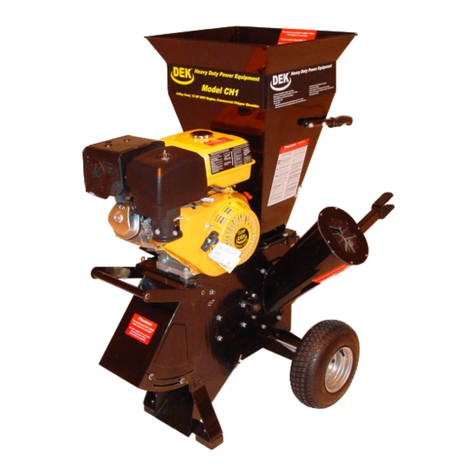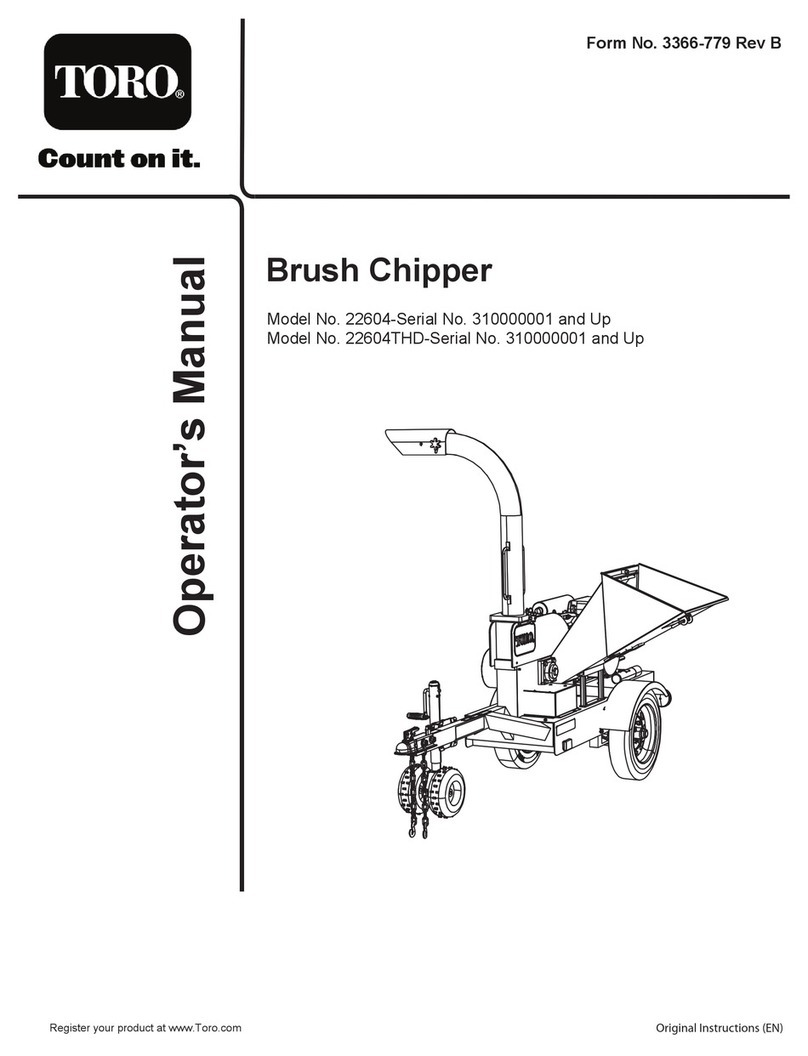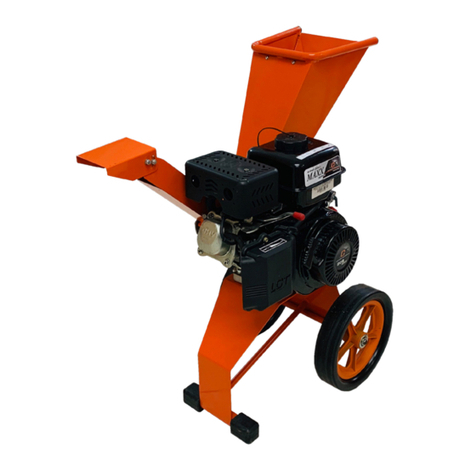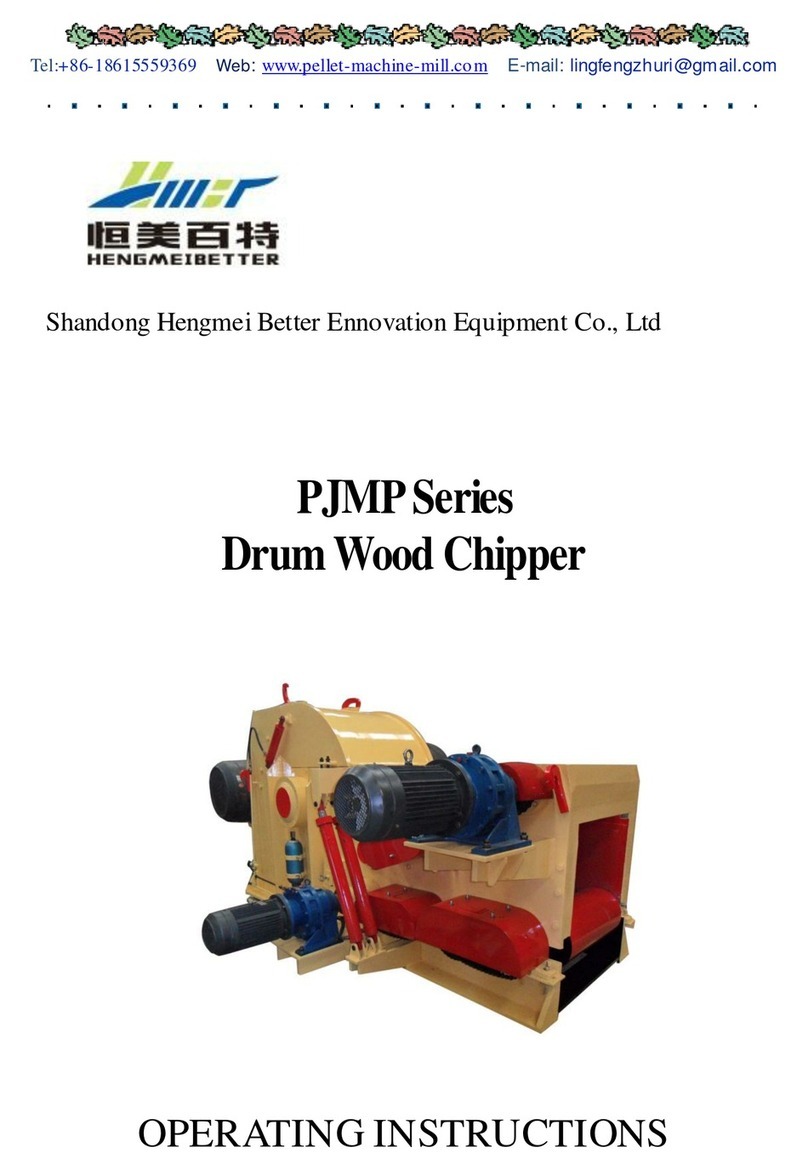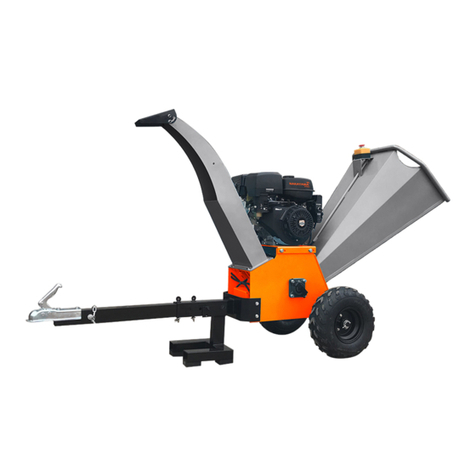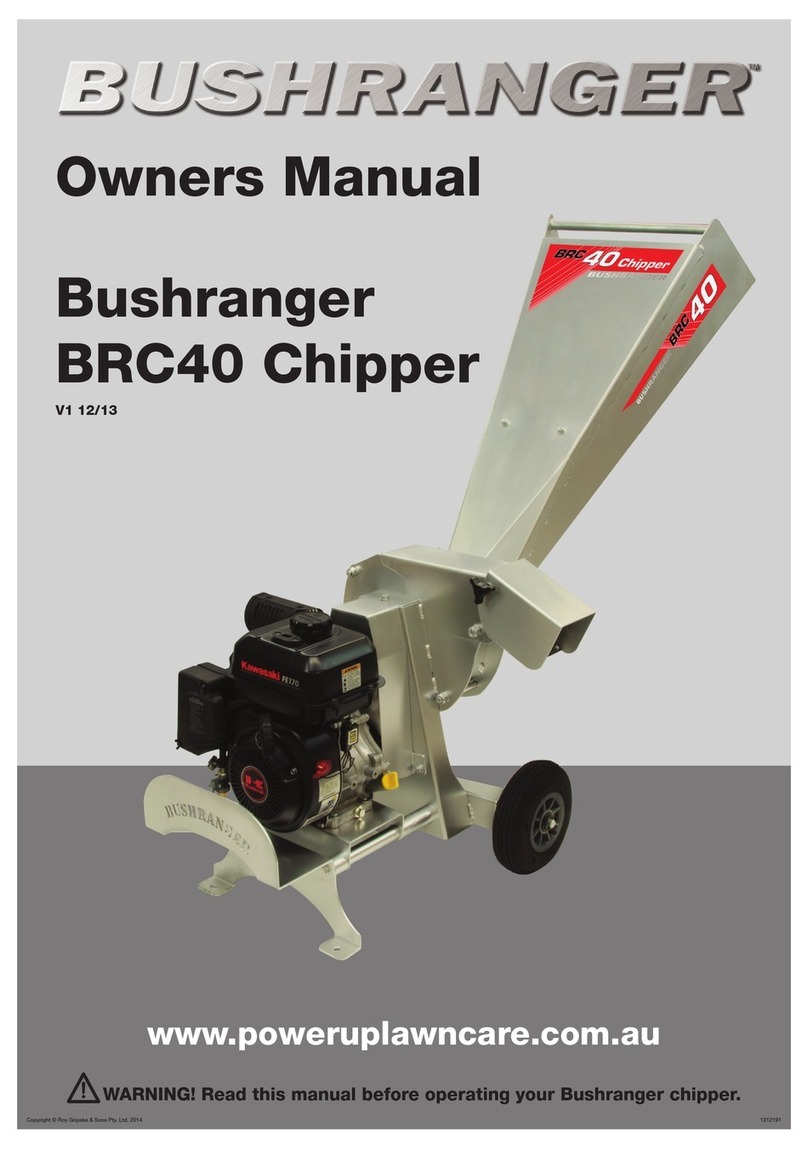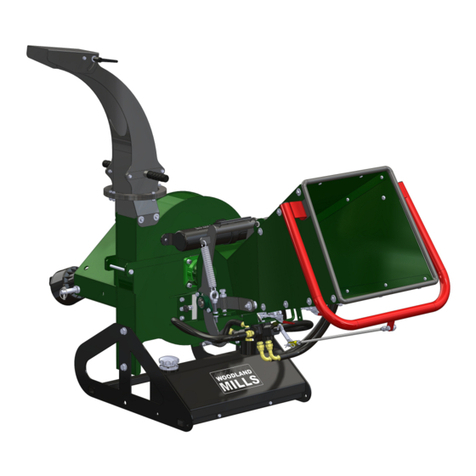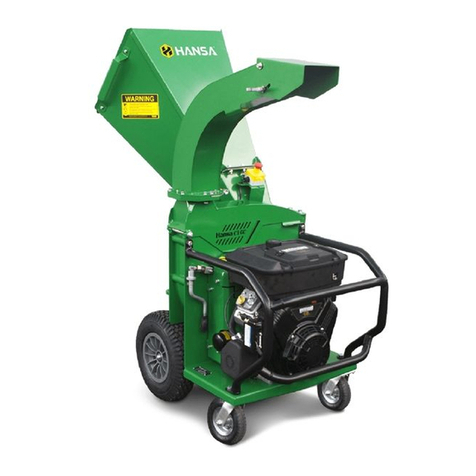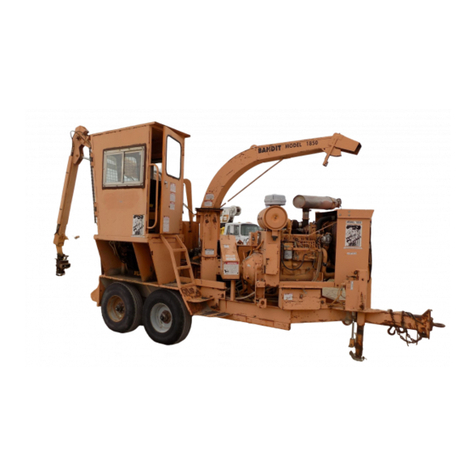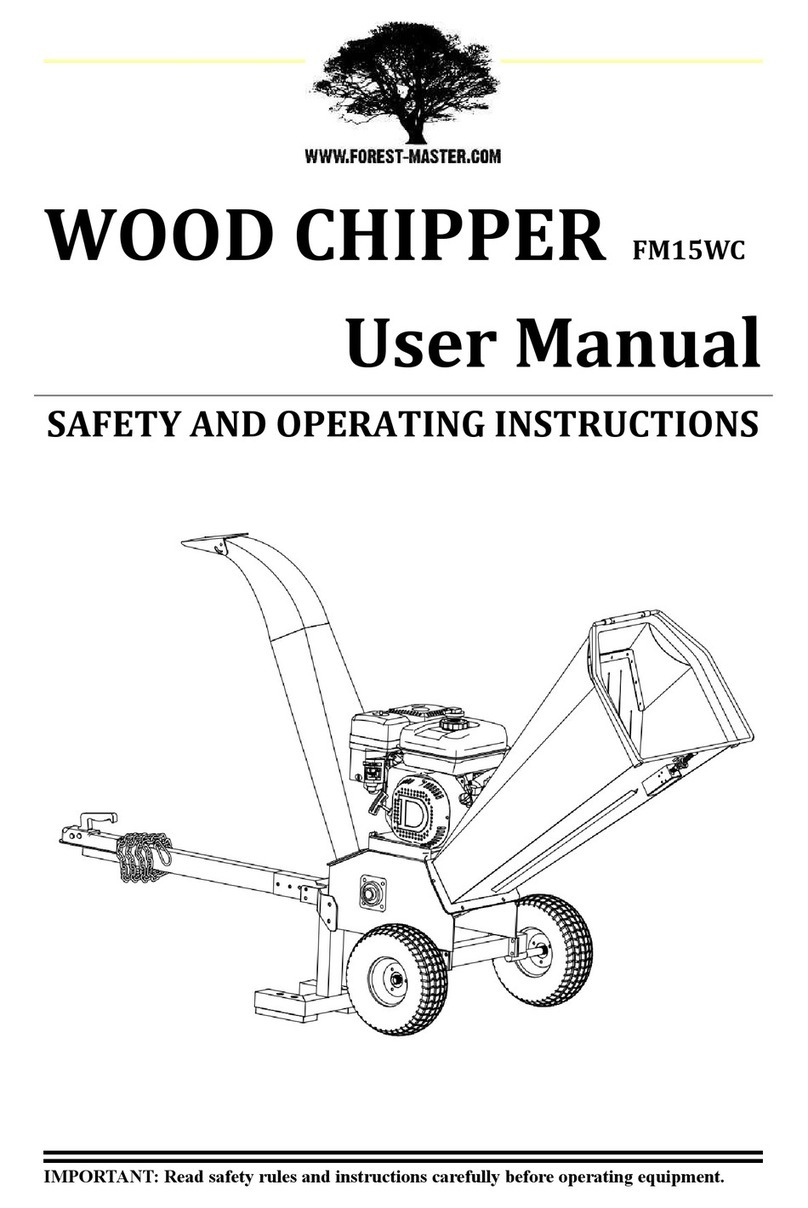Betstco FHM BX42 Series Application guide

Specifications subject to change without notice.
Specifications subject to change without notice.
OPERATION & PARTS MANUAL
Revision 1-2016
Please read these instructions carefully before using!
Always grease all fittings and be sure to always check and fill
with oil before operating! Retain this manual for future
reference.
BX42 SERIES WOOD CHIPPERS

2
Revision 1-2016
1 INTRODUCTION
Congratulations on your choice of a Farmer-Helper 3 Point Hitch Wood Chipper to compliment your
operation. This equipment has been designed and manufactured to meet the needs of a discerning
timber or landscaping industry.
Safe, efficient and trouble free operation of your Farmer-Helper Wood Chipper requires that you and
anyone else who will be using or maintaining the chipper, read and understand the Safety, Operation,
Maintenance Trouble Shooting information contained within the Operator's Manual.
BX42
This manual covers the Farmer-Helper 3 Point Hitch Wood Chipper BX42 Use the Table of
Contents or Index as a guide to locate required information.
Keep this manual handy for frequent reference and to pass on to new operators or owners.
OPERATOR ORIENTATION - The directions left, right, front and rear, as mentioned throughout this
manual, are determined when sitting in the tractor driver's seat and facing in the direction of travel.

3
Revision 1-2016
SAFETY ALERT SYMBOL
This Safety Alert symbol means
ATTENTION! BECOME ALERT!
YOUR SAFETY IS INVOLVED!
The Safety Alert symbol identifies
important safety messages on the
Farmer-Helper 3 Point Hitch
Wood Chipper and in the manual.
When you see this symbol, be
alert to
the possibility of personal injury or
death. Follow the instructions in the
safety message.
Why is SAFETY important to you?
3 Big Reasons
Accidents Disable and Kill
Accidents Cost
Accidents Can Be Avoided
SIGNAL WORDS:
Note the use of the signal words DANGER,
WARNING and CAUTION with the safety
messages. The appropriate signal word for
each message has been selected using the
following guide-lines:
DANGER - Indicates an imminently hazardous
situation that, if not avoided, will
result in death or serious injury. This
signal word is to be limited to the
most extreme situations typically for
machine components which, for
functional purposes, cannot be
guarded.
WARNING -Indicates a potentially hazardous
situation that, if not avoided, could
result in death or serious injury, and
includes hazards that are exposed
when guards are removed. It may
also be used to alert against unsafe
practices.
CAUTION -Indicates a potentially hazardous
situation that, if not avoided, may
result in minor or moderate injury. It
may also be used to alert against
unsafe practices.

4
Revision 1-2016
YOU are responsible for the SAFE operation and
maintenance of your Farmer-Helper 3 Point
Hitch Wood Chipper. YOU must ensure that you
and anyone else who is going to use, maintain or
work around the 3 Point Hitch Wood Chipper be
familiar with the using and maintenance
procedures and related SAFETY information
contained in this manual. This manual will take
you step-by-step through your working day and
alerts you to all good safety practices that should
be used while using the 3 Point Hitch Wood
Chipper.
Remember, YOU are the key to safety. Good
safety practices not only protect you but also the
people around you. Make these practices a
working part of your safety program. Be certain
that EVERYONE using this equipment is familiar
with the recommended using and maintenance
procedures and follows all the safety precautions.
Most accidents can be prevented. Do not risk
injury or death by ignoring good safety practices.
• 3 Point Hitch Wood Chipper owners must give
operating instructions to operators or
employees before allowing them to operate
the machine, and at least annually thereafter.
• The most important safety device on this
equipment is a SAFE operator. It is the
operator’s responsibility to read and
understand ALL Safety and Operating
instructions in the manual and to follow these.
Most accidents can be avoided.
• A person who has not read and understood all
using and safety instructions is not qualified
to use the machine. An untrained operator
exposes himself and bystanders to possible
serious injury or death.
• Do not modify the equipment in any way.
Unauthorized modification may impair the
function and/or safety and could affect the life
of the equipment.
• Think SAFETY! Work SAFELY!
2.1 GENERAL SAFETY
1. Read and understand the
Operator’s Manual and all
safety signs before using,
maintaining, adjusting or
cleaning the
3 Point Hitch Wood Chipper.
2. Have a first-aid kit available
for use should the need
arise and know how to use
it.
3. Have a fire extinguisher
available for use should the
need arise and know how to
use it.
4. Do not allow riders.
5. Wear appropriate
protective gear. This
list includes but is not
limited to:
- A hard hat
- Protective
shoes with slip
resistant soles
- Protective glasses,
goggles or face shield
- Heavy gloves
- Wet weather gear
- Hearing Protection
- Respirator or filter mask
6. Install and secure all guards
before starting.
7. Wear suitable ear protection
for prolonged exposure to
excessive noise.
8. Turn machine off, stop and
disable engine, remove ignition key and place
in your pocket, set park brake and wait for all
moving parts to stop before servicing,
adjusting, repairing or unplugging.
9. Clear the area of people, especially small
children, before using the unit.
10. Review safety related items annually with all
personnel who will operating or maintaining
the 3 Point Hitch Wood Chipper.
2 SAFETY

5
Revision 1-2016
2.2 EQUIPMENT SAFETY GUIDELINES
1. Safety of the operator and bystanders is one
of the main concerns in designing and
developing equipment. However, every year
many accidents occur which could have been
avoided by a few seconds of thought and a
more careful approach to handling equipment.
You, the operator, can avoid many accidents
by observing the following precautions in this
section. To avoid personal injury or death,
study the following precautions and insist
those working with you, or for you to follow
them.
2. In order to provide a better view, certain
photographs or illustrations in this manual
may show an assembly with a safety shield
removed. However, equipment should never
be used in this condition. Keep all shields in
place. If shield removal becomes necessary
for repairs, replace the shield prior to use.
3. Replace any safety sign or instruction sign
that is not readable or is missing. Location of
such safety signs is indicated in this manual.
4. Never use alcoholic beverages or drugs which
can hinder alertness or coordination while
using this equipment. Consult your doctor
about using this machine while taking
prescription medications.
5. Under no circumstances should young
children be allowed to work with this
equipment. Do not allow persons to use or
assemble this unit until they have read this
manual and have developed a thorough
understanding of the safety precautions
and of how it works. Review the safety
instructions with all users annually.
6. This equipment is dangerous to children and
persons unfamiliar with its operation. The
operator should be a responsible, properly
trained and physically able person familiar
with machinery and trained in this equipment's
operations. If the elderly are assisting with
work, their physical limitations need to be
recognized and accommodated.
7. Never exceed the limits of a piece of
machinery. If its ability to do a job, or to do so
safely, is in question - DON'T TRY IT.
8. Do not modify the equipment in any way. Un-
authorized modification may result in serious
injury or death and may impair the function
and life of the equipment.
9. In addition to the design and configuration of
this implement, including Safety Signs and
Safety Equipment, hazard control and
accident prevention are dependent upon the
awareness, concern, prudence, and proper
training of personnel involved in the operation,
transport, maintenance, and storage of the
machine. Refer also to Safety Messages and
operation instruction in each of the appropriate
sections of the tractor and machine manuals.
Pay close attention to the Safety Signs affixed
to the tractor and the machine.

6
Revision 1-2016
2.3 SAFETY TRAINING
1. Safety is a primary concern in the design and
manufacture of our products. Unfortunately,
our efforts to provide safe equipment can
be wiped out by a single careless act of an
operator or bystander.
2. In addition to the design and configuration of
equipment, hazard control and accident
prevention are dependent upon the
awareness, concern, prudence and proper
training of personnel involved in the operation,
transport, maintenance and storage of this
equipment.
3. It has been said, "The best
safety feature is an
informed, careful operator."
We ask you to be that
kind of an operator. It is the
operator's responsibility to read and under-
stand ALL Safety and Using instructions in the
manual and to follow these. Accidents can be
avoided.
4. Working with unfamiliar equipment can
lead to careless injuries. Read this manual
before assembly or using, to acquaint
yourself with the machine. If this machine
is used by any person other than yourself,
or is loaned or rented, it is the machine
owner's responsibility to make certain that
the operator, prior to using:
a. Reads and understands the operator's
manuals.
b. Is instructed in safe and proper use.
5. Know your controls and how to stop tractor
and machine quickly in an emergency. Read
this manual and the one provided with tractor.
6. Train all new personnel and review
instructions frequently with existing workers.
Be certain only a properly trained and
physically able person will use the machinery.
A person who has not read and understood all
using and safety instructions is not qualified to
use the machine. An untrained operator
exposes himself and bystanders to possible
serious in- jury or death. If the elderly are
assisting with the work, their physical
limitations need to be recognized and
accommodated.
2.4 SAFETY SIGNS
1. Keep safety signs clean and legible at all
times.
2. Replace safety signs that are missing or have
become illegible.
3. Replaced parts that displayed a safety sign
should also display the current sign.
4. Safety signs displayed in Section 3 each have
a part number in the lower right hand corner.
Use this part number when ordering
replacement parts.
5. Safety signs are available from your
authorized Distributor or Dealer Parts
Department or the factory.
How to Install Safety Signs:
• Be sure that the installation area is clean and
dry.
• Be sure temperature is above 50°F (10°C).
• Determine exact position before you remove
the backing paper.
• Remove the smallest portion of the split
backing paper.
• Align the sign over the specified area and
carefully press the small portion with the ex-
posed sticky backing in place.
• Slowly peel back the remaining paper and
carefully smooth the remaining portion of the
sign in place.
• Small air pockets can be pierced with a pin
and smoothed out using the piece of sign
backing paper.

7
Revision 1-2016
2.5 PREPARATION
1. Never use the machine until you have read
and completely understand this manual, the
tractor Operator's Manual and each of the
Safety Messages found on the safety signs on
the tractor and machine.
2. Personal pro-
tection equip-
ment including
hard hat, safety
glasses, safety
shoes, and
gloves are rec-
ommended dur-
ing assembly,
installation, operation, adjustment, maintain-
ing, repairing, removal, cleaning, or moving
the unit. Do not allow long hair, loose fitting
clothing or jewellery to be around equipment.
3. PROLONGED EXPOSURE
TO LOUD NOISE MAY
CAUSE PERMANENT
HEARING LOSS!
Power equipment with or
without equipment attached
can often be noisy enough
to cause permanent, partial
hearing loss. We recommend that you wear
hearing protection on a full-time basis if the
noise in the Operator's position exceeds 80db.
Noise over 85db on a long-term basis can
cause severe hearing loss. Noise over 90db
adjacent to the Operator over a long-term ba-
sis may cause permanent, total hearing loss.
NOTE: Hearing loss from loud noise (from
tractors, chain saws, radios, and other such
sources close to the ear) is cumulative over a
lifetime without hope of natural recovery.
4. Clear working area of stones, branches or
hidden obstacles that might be hooked or
snagged, causing injury or damage.
5. Use only in daylight or good artificial light.
6. Be sure machine is properly mounted, adjust-
ed and in good operating condition.
7. Ensure that all safety shielding and safety
signs are properly installed and in good condi-
tion.
2.6 MAINTENANCE SAFETY
1. Good maintenance is your responsibility.
Poor
maintenance is an invitation to trouble.
2. Follow good shop practices.
- Keep service
area clean and
dry.
- Be sure electrical
outlets and tools
are properly
grounded.
- Use adequate
light for the job at
hand.
3. Make sure there is
plenty of ventilation. Never operate the en-
gine of the towing vehicle in a closed
building.
The exhaust fumes may cause asphyxiation.
4. Before working on this machine, shut off the
engine, set the brake, and turn fuel valve off.
5. Never work under equipment unless it is
blocked securely.
6. Always use personal protection devices such
as eye, hand and hearing protectors, when
performing any service or maintenance work.
Use heavy or leather gloves when handling
blades.
7. Where replacement parts are necessary for
periodic maintenance and servicing, genuine
factory replacement parts must be used to
restore your equipment to original specifica-
tions. The manufacturer will not be responsi-
ble for injuries or damages caused by use of
unapproved parts and/or accessories.
8. A fire extinguisher and first aid kit should be
kept readily
accessible while
performing main-
tenance on this
equipment.
9. Periodically tighten all bolts,
nuts and screws and check that all electrical
and fuel connections are properly secured to
ensure unit is in a safe condition.

8
Revision 1-2016
2.7
OPERATING
SAFETY
1. Please remember it is important that you read
and heed the safety signs on the 3 Point Hitch
Wood Chipper. Clean or replace all safety
signs if they cannot be clearly read and under-
stood. They are there for your safety, as well
as the safety of others. The safe use of this
machine is strictly up to you, the operator.
2. All things with moving parts are potentially
hazardous. There is no substitute for a cau-
tious, safe-minded operator who recognizes
potential hazards and follows reasonable
safety practices. The manufacturer has
designed this 3 Point Hitch Wood Chipper to
be used with all its safety equipment properly
attached, to minimize the chance of accidents.
Study this manual to make sure you have all
safety equipment attached.
3. Close and secure rotor cover before operat-
ing.
4. Close and secure all guards, deflectors and
shields before starting and operating.
5. Read and understand operator's manual
before starting. Review safety instructions
annually.
6. Personal protection equipment including hear-
ing protection, hard hat, safety glasses, safety
shoes, and gloves are recommended during
assembly, installation, operation, adjustment,
maintaining, repairing, removal, or moving.
Do not allow long hair, loose-fitting clothing, or
jewelery to be around moving parts.
7. Keep hydraulic lines and fittings tight, in good
condition and free of leaks.
8. Never place any part of your body where it
would be in danger if movement should occur
during assembly, installation, operation, main-
tenance, repairing, unplugging or moving.
9. Turn machine off, stop and disable engine,
remove ignition key and place in your pocket,
set park brake and wait for all moving parts to
stop before servicing, adjusting, repairing or
unplugging.
10. Do not run machine inside a closed building to
prevent asphyxiation from engine exhaust.
11. Use care when feeding material into chipper.
Do not send metal, bottles, cans, rocks, glass
or other foreign material into wood chipper. If
foreign material enters chipper, stop machine,
turn engine off and place ignition key in your
pocket and wait for all moving parts to stop
before removing material and/or unplugging.
Inspect machine for damaged or loose parts
before resuming work.
12. Never use alcoholic beverages or drugs which
can hinder alertness or coordination while
operating this equipment. Consult your doc-
tor about operating this machine while taking
prescription medications.
13. Do not allow riders on this machine at any
time. There is no safe place for any riders.
14. Never allow children or unauthorized people
to operate or be around this machine.
15. Do not reach into rotor or feed hopper open-
ings when the engine is running. Install and
secure access covers before starting engine.
16 Keep the working area clean and free of de-
bris to prevent tripping. Operate only on level
ground.
17 Do not point discharge at people, animals or
buildings. Rotor can expel wood chips fast
enough to cause injury.
18. Do not move or transport chipper when the
rotor is turning.
19. Do not exceed a safe travel speed when
transporting.

9
Revision 1-2016
2.8 STORAGE SAFETY
1. Store the unit in an area away from human
activity.
2. Do not children to play on or around the
stored machine.
3. Store the unit in a dry, level area. Support the
frame with planks if required.
2.9 TRANSPORT SAFETY
1. Comply with state and local laws governing
safety and transporting of machinery on public
roads.
2. Check that all the lights, reflectors and other
lighting requirements are installed and in good
working condition.
3. Do not exceed a safe travel speed. Slow
down for rough terrain and cornering.
4. Fold up and secure feed hopper before mov-
ing or transporting.
5. Be sure the machine is hitched positively to
the tractor and a retainer is used through the
mounting pins.
6. Do not drink and drive.
7. Be a safe and courteous driver. Always yield
to oncoming traffic in all situations, including
narrow bridges, intersections, etc. Watch for
traffic when operating near or crossing road-
ways.
8. Never allow riders on the machine.

10
Revision 1-2016
3 SAFETY SIGN LOCATIONS
The types of safety signs and locations on the equipment are shown in the illustrations that follow. Good
safety requires that you familiarize yourself with the various safety signs, the type of warning and the
area, or particular function related to that area, that requires your SAFETY AWARENESS.
• Think SAFETY! Work SAFELY!
D
AF
B
A
B
Z9400
Z94006
REMEMBER - If safety signs have been damaged, removed, become illegible or parts replaced without
safety signs, new signs must be applied. New safety signs are available from your authorized dealer.

11
Revision 1-2016
The types of safety signs and locations on the equipment are shown in the illustrations that follow. Good
safety requires that you familiarize yourself with the various safety signs, the type of warning and the
area, or particular function related to that area, that requires your SAFETY AWARENESS.
B
B
DD
CD
DANGER
THROWN OBJECT HAZARD
To prevent serious injury or death from
thrown objects:
• Turn machine off, stop and disable en-
gine, remove ignition key and place in
your pocket, set park brake and wait for
all moving parts to stop before adjusting,
servicing, maintaining, repairing or un-
plugging.
• Do not direct discharge duct towards
people, animals or property. Always wear
appropriate safety gear. Keep hands and
feet out of discharge openings.
Z940 3
• Keep others away. Z9400
REMEMBER - If safety signs have been damaged, removed, become illegible or parts replaced without
safety signs, new signs must be applied. New safety signs are available from your authorized dealer.

12
Revision 1-2016
The types of safety signs and locations on the equipment are shown in the illustrations that follow. Good
safety requires that you familiarize yourself with the various safety signs, the type of warning and the
area, or particular function related to that area, that requires your SAFETY AWARENESS.
H
J
HJ
DANGER DANGER
ROTATING DRIVELINE HAZARD
CONTACT CAN CAUSE DEATH
KEEP AWAY!
DO NOT OPERATE WITHOUT:
• ALL DRIVELINE, TRACTOR AND
EQUIPMENT SHIELDS IN PLACE.
• DRIVELINES SECURELY AT-
TACHED AT BOTH ENDS.
• DRIVELINE SHIELDS THAT TURN
GUARDS MISSING
DO NOT OPERATE
DANGER
GUARDS MISSING
DO NOT OPERATE Z940 3
FREELY ON DRIVELINE. Z940 0 DANGER
REMEMBER - If safety signs have been damaged, removed, become illegible or parts replaced without
safety signs, new signs must be applied. New safety signs are available from your authorized dealer.

13
Revision 1-2016
4 ASSEMBLING
The machine comes from the factory in a shipping
configuration. Always use tools equipment and
forklifts of appropriate size and capacity for the
job. Always use 2 men when lifting, moving and
assembling the machine.
When the machine is shipped, follow this proce-
dure when preparing for the customer:
1. Clear the area of bystanders especially small
children before starting.
2. Use a forklift to lift the pallet/machine from the
truck. Carry the load close to the ground.
3. Move the machine to the assembly area. Be
sure there is sufficient clearance to access the
machine from all sides.
BX42
Fig. 1 SHIPPING
4. Cut the tie-down straps.
Fig. 2 TIE-DOWNS
5. Lay-out components next to machine.

14
Revision 1-2016
6. Use a forklift to raise and lift the frame.
7. Or alternatively attach a lifting device to the
lifting bracket on top of the frame.
8. Remove pallet and place machine on the
ground.
Fig. 4 LIFTING
Forklift
Bracket
Fig. 5 PALLET REMOVED

15
Revision 1-2016
9. Release feed hopper transport latch and lower
hopper into the working position. Stow anchor
latch.
Fig. 6 HOPPER TRANSPORT LATCH
10. Tighten anchor bolts to their specified torque.
Fig. 7 ANCHOR BOLTS (TYPICAL)

16
Revision 1-2016
11. Connect the PTO drivline:
a. Raise the input shaft guard.
b. Check that the driveline telescopes eas-
ily and that the shield rotates freely.
c. Attach the driveline to the chipper input
shaft by depressing the lock pin, slide
yoke over the shaft and pushing on the
yoke until the lock pin clicks into posi-
tion.
NOTE
Be sure the yoke with the shear pin
is attached to the machine shaft.
Aligning
d. Lower the guard to cover the input shaft.
Installed
Fig. 8 DRIVELINE (TYPICAL)
12. Depress handle on discharge chute
latch and turn assembly to its desired
position. Turn until latch seats in its
detent.
Fig. 9 DISCHARGE CHUTE

17
Revision 1-2016
5 OPERATION
OPERATING SAFETY
• Please remember it is important that
you
read
the operator's manual and heed the
safety signs on the 3 Point Hitch Wood Chip-
per. They are there for your safety, as well
as the safety of others. The safe use of this
machine is strictly up to you, the operator.
• Personal protection equipment including
hearing protection, hard hat, safety glasses,
safety shoes, and gloves are recommended
during assembly, installation, operation, ad-
justment, maintaining, repairing, or plugging.
Do not allow long hair, loose-fitting clothing,
or jewellery to be around moving parts.
• Turn machine off, stop and disable engine,
remove ignition key and place in your pocket,
set park brake and wait for all moving parts
to stop before servicing, adjusting, repairing
or unplugging.
• Do not run machine inside a closed building
to prevent asphyxiation from engine exhaust.
• Use care when feeding material into chipper.
Do not send metal, bottles, cans, rocks, glass
or other foreign material into wood chipper. If
foreign material enters chipper, stop ma-
chine, turn engine off and place ignition key
in your pocket and wait for all moving parts to
stop before removing material and/or unplug-
ging. Inspect machine for damaged or loose
parts before resuming work.
• Never use alcoholic beverages or drugs
which can hinder alertness or coordination
while operating this equipment. Consult
your doctor about operating this machine
while taking prescription medications.
• Do not allow riders on this machine at any
time. There is no safe place for any riders.
• Never allow children or unauthorized people
to operate or be around this machine.
• Do not reach into rotor or feed hopper open-
ings when the engine is running. Install and
secure access covers before starting en-
gine.
• Do not move or transport chipper when the
rotor is turning.
• Do not exceed a safe travel speed when
transporting.
• Keep hydraulic lines and fittings tight, in
good condition and free of leaks.
• Keep the working area clean and free of
debris to prevent tripping. Operate only on
level ground.
• Do not point discharge at people, animals or
buildings. Rotor can expel wood chips fast
enough to cause injury.
5. 1 TO THE NEW OPERATOR OR OWNER
The Farmer-Helper 3 Point Hitch Wood
Chippers
are designed to chip or chop scrap lumber, small
trees, brush, limbs and other wood debris. The
chipped material is fine enough to be composted
or used in a variety of ways.
It is the responsibility of the owner or opera-
tor to read this manual and to train all other
operators before they start working with the
machine. Follow all safety instructions exact-
ly. Safety is everyone's business. By follow-
ing recommended procedures, a safe working
environment is provided for the operator,
bystanders and the area around the worksite.
Untrained operators are not qualified to use
the machine.
Follow all safety instructions exactly. Safety
is everyone's business. By following recom-
mended procedures, a safe working environ-
ment is provided for the operator, bystanders
and the area around the worksite. Untrained
operators are not qualified to operate the
machine.
Many features incorporated into this machine are
the result of suggestions made by customers like
you. Read this manual carefully to learn how to
use the chipper safely and how to set it to provide
maximum field efficiency. By following the using
instructions in conjunction with a good mainte-
nance program, your 3 Point Hitch Wood Chipper
will provide many years of trouble-free service.

18
Revision 1-2016
5.2 MACHINE COMPONENTS
The Farmer-Helper 3
Point Hitch Wood
Chipper
is a rotor with
blades
for chip- ping
wood. A
hinged feed
hopper
moves
the wood
material into the rotor.
Each rotor
is
designed
with
4
blades
and a twig-break-
er to
generate
the small
pieces of wood. A station-
ary
knife
at the rear of the
rotor
housing
is
placed
by
the
moving knives
to
shear,
chip or
chop
the material.
The
tractor
provides
rotational
power
through
a PTO
shaft
on
the front
of the
frame
and
hydraulic
power for the hydraulic
feed hopper.
A Manual Feed Hopper
B Discharge Hood
C Rotor Housing
D Rotor Blade
E Stationary Blade
F Twig Breaker
G Hood Deflector
H Hydraulic Feed Hopper
J Hydraulic Feed Control
K Hydraulic Motor
L PTO Driveline
M Rotor
N Paddle
O 3 Point Hitch
Fig. 1 0 PRINCIPLE COMPONENTS

19
Revision 1-2016
5.3 MACHINE BREAK-IN
Although there are no operational restrictions on
the Wood Chipper when used for the first time,
it is recommended that the following mechanical
items be checked:
A. After operating for 1 hour:
1. Torque all fasteners and hardware.
2. Check condition of rotor bearings.
3. Check the condition and clearance of the
twig-breaker, rotor and stationary blades.
Adjust or replace as required.
4. Check for entangled material. Remove all
entangled material before resuming work.
5. Lubricate all grease fittings.
B. After operating for 10 hours:
1. Repeat steps 1 through 5 listed above.
(Section A)
2. Go to the normal servicing and mainte-
nance schedule as defined in the Mainte-
nance Section.
5.4 PRE-OPERATION CHECKLIST
Efficient and safe operation of the Farmer-Helper
3 Point Hitch Wood Chipper requires that each
operator reads and understands the using proce-
dures and all related safety precautions outlined
in this section. A pre-operation checklist is pro-
vided for the operator. It is important for both the
personal safety and maintaining good mechanical
condition that this checklist is followed.
Before operating the Wood Chipper and each time
thereafter, the following areas should be checked
off:
1. Lubricate the machine per the schedule out-
line in the Maintenance Section.
2. Check the rotor, blades and twig-breaker.
Remove any twine, wire or other material that
has become entangled.
3. Check the condition and clearance of the twig-
breaker, rotor and stationary blades. Adjust or
replace as required.
4. Check that all bearings turn freely. Replace
any that are rough or seized.
5. Make sure that all guards and shields are in
place, secured and functioning as designed.
6. Check the condition of the curtain in the feed
hopper. It must be in good condition to pre-
vent chips from flying out.

20
Revision 1-2016
5. 5 DRIVELINE DIMENSION
A PTO driveline is supplied with the machine. To ac-
company the variety of 3 point hitch geometry available
today, the driveline can be too long for most machines
or too short for others. It is very important that the drive-
line be free to telescope but not to bottom out when
going through its working range. If the driveline bottoms
out, the bearings on both the machine and tractor PTO
shaft will be overloaded and fail in a short time.
1. To determine the proper length of the driveline,
follow this procedure:
a. Clear the area of bystanders, especially small
children.
b. Attach the chipper to the tractor (see section
5.8) but do not attach the driveline.
Fig. 11 DRIVELINE DIMENSIONS
c. Raise the machine until the input shaft is level with
the tractor PTO shaft.
d. Measure the dimension between the locking
grooves on the tractor PTO shaft and the machine
input shaft.
e. Measure the same dimensions on the compressed
driveline.
f. If the compressed driveline dimension exceeds the
machine dimension, the driveline will have to be cut.
2. When cutting the driveline, follow this procedure:
a. Subtract the machine dimension (A) from the uncut
driveline dimension (B) or (B-A). This dimension
determines how much too long the driveline is.
b. Add another inch (25 mm) to the dimension
to be sure it doesn't bottom out, to determine
(C) the cut off dimension.
c. Use a hacksaw to cut dimension (C) from
both ends. Cut both the plastic tubes and
the metal cores.
Fig. 1 2 CUT OFF DIMENSION
d. Use a file to remove the burrs from the
edges that were cut.
e. Assemble the 2 ends of the shaft.
Fig. 1 3 SHORTENING
f. Make sure the shaft can telescope freely. If it does
not, separate the 2 parts and inspect for burrs or
cuttings on the shaft ends. Be sure it telescopes
freely before installing.
This manual suits for next models
1
Table of contents
Other Betstco Chipper manuals
